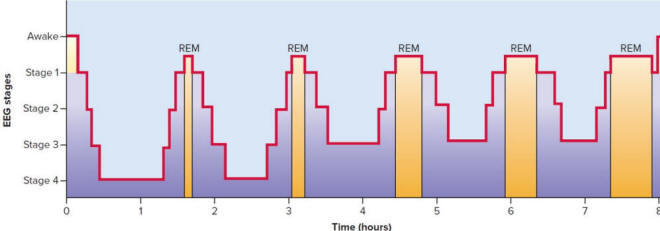Sleep Cycles
Every night our brain goes through four different stages of sleep. Each stage has different effects on your body, from physical restoration during deep sleep, to memory consolidation during dreams. All together, these stages add up to approximately ninety minutes, making up one complete sleep cycle. These four main categories or stages may be differentiated by levels of brain activity (EEG) and the depth of sleep.
Stage 1. Is a transition stage between wakefulness and sleep that normally lasts 1–7 minutes. One feels drowsy, closes the eyes, and begins to relax. Thoughts come and go, often accompanied by a drifting sensation. One awakens easily if stimulated. The EEG is dominated by alpha waves. People awakened during this stage often say they have not been sleeping.
Stage 2. One passes into light sleep (first stage of “true sleep”). The EEG declines in frequency but increases in amplitude. Occasionally it exhibits 1 or 2 seconds of sleep spindles, high spikes resulting from interactions between neurons of the thalamus and cerebral cortex. In it, a person is easy to awaken. Fragments of dreams may be experienced and the eyes may slowly roll from side to side.
Stage 3. This is moderate to deep sleep, typically beginning about 20 minutes after stage 1. Sleep spindles occur less often, and theta and delta waves appear. The muscles relax, and the vital signs (body temperature, blood pressure, and heart and respiratory rates) fall.
Stage 4. This is the deepest level of sleep, also called slow-wave sleep (SWS), because the EEG is dominated by low-frequency, high-amplitude delta waves. The muscles are now very relaxed, vital signs are at their lowest levels, brain metabolism decreases significantly and body temperature drops slightly at this time and most reflexes are intact. During this stage, it is very difficult to awaken a person.

Sleep stages and brain activity – 8 hour sleep cycle (reference)
Normal sleep consists of two components: Non-rapid eye movement (NREM) sleep and Rapid eye movement (REM) sleep. Several physiological changes occur during NREM sleep. There are decreases in heart rate, respiratory rate, and blood pressure. Muscle tone also decreases, out only slightly. As a result, there is a moderate amount of muscle tone during NREM sleep, which allows the sleeping person to shift body positions. Dreaming sometimes takes place during NREM sleep but only occasionally. However, most dreaming occurs during REM sleep. When dreaming does occur during NREM sleep, the dreams are usually less vivid, less emotional, and more logical than REM dreams. Most nightmares, however, occur during NREM sleep.
During REM sleep, the eyes move rapidly back and forth under closed eyelids. REM sleep is also known as paradoxical sleep because EEG readings taken during this time show high-frequency, small amplitude waves, which are similar to those of a person who is awake. Surprisingly, neuronal activity is high during REM sleep. Blood flow in the brain and oxygen use are actually higher during REM sleep than during intense mental or physical activity while awake! In spite of this high amount of neuronal activity, it is even more difficult to awaken a person during REM sleep than during any of the stages of NREM sleep. REM sleep is associated with several physiological changes. For example, heart rate, respiratory rate, and blood pressure increase during REM sleep. In addition, most somatic motor neurons are inhibited during REM sleep, which causes a significant decrease in muscle tone and even paralyzes the skeletal muscles. The main exceptions to this inhibition are those somatic motor neurons that govern breathing and eye movements. REM sleep is also the period when most dreaming occurs.
Brain imaging studies on people going through REM sleep reveal that there is increased activity in both the visual association area (which is involved in recognition of visual images) and limbic system (which plays a major role in generation of emotions) and decreased activity in the prefrontal cortex (which is concerned with reasoning). These studies help to explain why dreams during REM sleep are often full of vivid imagery, emotional responses, and situations that may be illogical or even bizarre. Erection of the penis and enlargement of the clitoris may also occur during REM sleep, even when dream content is not sexual. (reference)
According to Thomas Yuschak, it is interesting to note that one's body strives to maintain a balanced sleep schedule. It is very difficult nor desired to deprive one's body of deep sleep or of REM sleep. Deep sleep is strongly associated with body rejuvenation and is imperative for maintaining proper mental and physical health. It is well known that in times of sickness or injury our sleep schedule will shift to include longer and more frequent periods of deep sleep during which the body is healing itself. It is also well known that depriving our body of deep sleep can result in negative effects on both our mental and physical health including a weakened immune system, increased levels of agitation and stress, and a generally lower feeling of well being.
See also: Booze and dreams, Dreams and brain disorders, Dreams as a source of inspiration, Essential oils, Food and dreams, Hypnagogic state, Neuroprotective agents, Sleeping brain, Sleep deprivation, Weed and dreams

Connect with us
Contact us today